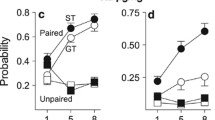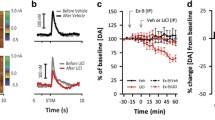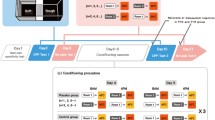Abstract
Morphine is known to act centrally to produce discriminative stimulus effects, but the specific neuroanatomical sites mediating this action have not been identified. We used morphine as a discriminative stimulus in a taste aversion paradigm to elucidate the neural basis of morphine's cueing properties. Rats were injected subcutaneously with 5 mg/kg morphine 15 min prior to the presentation of a 0.1% saccharin solution. After 20 min of exposure to the flavor, lithium chloride (130 mg/kg, IP) was injected. On alternate days, an injection of 0.9% physiological saline both preceded and followed the presentation of saccharin. Animals learned to consume significantly less saccharin after morphine than after saline injections. Unilateral guide cannulae were then implanted into brain areas containing relatively high densities of opiate binding sites, comprising the medial prefrontal cortex, the nucleus accumbens, the anterior dorsolateral striatum, the medial thalamus, the basolateral amygdaloid nucleus, the dorsal hippocampus, the caudal periaqueductal grey and the parabrachial nucleus. Generalization to central routes of administration was then evaluated by microinjecting morphine (2.5, 5, 10 and 20 µg) into these brain areas. Dose-dependent decreases in saccharin consumption similar to those of systemic morphine were produced by the administration of morphine into the parabrachial nucleus and the nucleus accumbens. Control data showed that only in the parabrachial nucleus could these effects be attributed to the cueing properties of morphine; in the nucleus accumbens, morphine administration induced unconditioned decreases in saccharin consumption. In the remaining brain areas, morphine generalized to the systemic saline condition. The data point to ascending visceral pathways (parabrachial nucleus), but not dopamine terminal fields (nucleus accumbens), as possible substrates for opiate discriminative effects. These putative discriminative substrates are distinct from the medial forebrain bundle pathways mediating the positive reinforcing effects of opiates.
Similar content being viewed by others
References
Atweh SF, Kuhar MJ (1977a) Autoradiographic localization of opiate receptors in rat brain. II. The brain stem. Brain Res 129:1–12
Atweh SF, Kuhar MJ (1977b) Autoradiographic localization of opiate receptors in rat brain. III. The telencephalon. Brain Res 134:393–405
Bozarth MA, Wise RA (1983) Dissociation of the rewarding and physical dependence-producing properties of morphine. In: Harris LS (ed) Problems of drug dependence, 1982. National Institute on Drug Abuse, Washington, DC, pp 171–177
Bozarth MA, Wise RA (1984) Anatomically distinct opiate receptor fields mediate reward and physical dependence. Science 224:516–517
Browne RG, Fondren B (1978) β-Endorphin and the narcotic cue. In: Colpaert FC, Rosecrans JA (eds) Stimulus properties of drugs: ten years of progress. Elsevier, Amsterdam, pp 137–147
Chipkin RE, Stewart JM, Morris DH, Crowley TJ (1978) Generalization of [dAla2)-enkephalinamide but not of substance P to the morphine cue. Pharmacol Biochem Behav 9:129–132
Colpaert FC (1978) Theoretical review: discriminative stimulus properties of narcotic analgesic drugs. Pharmacol Biochem Behav 9:863–887
Colpaert FC, Niemegeers CJE, Janssen PAJ, van Ree JM (1978) Narcotic cueing properties of intraventricularly administered sufentanil, fentanyl, morphine and met-enkephalin. Eur J Pharmacol 47:115–119
Daugé V, Rossignol P, Roques BP (1989) Blockade of dopamine receptors reverses the behavioral effects of endogenous enkephalins in the nucleus caudatus but not in the nucleus accumbens: differential involvement of δ and μ opioid receptors. Psychopharmacology 99:168–175
Freedman JE, Aghajanian GK (1985) Opiate and α2-adrenoceptor responses of rat amygdaloid neurons: co-localization and interactions during with drawal. J Neurosci 5:3016–3024
Fulwiler CE, Saper CB (1984) Subnuclear organization of the efferent connections of the parabrachial nucleus in the rat. Brain Res Rev 7:229–259
Gaston KE (1978) Brain mechanisms of conditioned taste aversion learning: a review of the literature. Physiol Psychol 6:340–353
Herkenham M, Pert CB (1982) Light microscopic localization of brain opiate receptors: a general autoradiographic method which preserves tissue quality. J Neurosci 2:1129–1149
Herling S, Woods JH (1981) Discriminative stimulus effects of narcotics: evidence for multiple receptor-mediated actions. Life Sci 28:1571–1584
Hill HE, Jones BE, Bell EC (1971) State dependent control of discrimination by morphine and pentobarbital. Psychopharmacologia 22:305–313
Holtzman SG (1983) Discriminative stimulus properties of opioid agonists and antagonists. In: Cooper SJ (ed) Theory in psychopharmacology, vol 2. Academic Press, London, pp 1–45
Ivanova SF, Bures J (1990) Acquisition of conditioned taste aversion in rats is prevented by tetrodotoxin blockade of a small midbrain region centered around the parabrachial nuclei. Physiol Behav 48:543–549
Jaeger TV, Mucha RF (1990) A taste aversion model of drug discrimination learning: training drug and condition influence rate of learning, sensitivity and drug specificity. Psychopharmacology 100:145–150
Locke KW, Holtzman SG (1985) Characterization of the discriminative stimulus effects of centrally administered morphine in the rat. Psychopharmacology 87:1–6
Locke KW, Holtzman SG (1986) Behavioral effects of opioid peptides selective formu ordelta receptors. I. Morphine-like discriminative stimulus effects. J Pharmacol Exp Ther 238:990–996
Lucki I (1988) Rapid discrimination of the stimulus properties of 5-hydroxytryptamine agonists using conditioned taste aversion. J Pharmacol Exp Ther 247:1120–1127
Martin GM, Gans M, van der Kooy D (1990) Discriminative properties of morphine that modulate associations between tastes and lithium chloride. J Exp Psychol [Anim Behav Proc] 16:56–68
Martin GM, Bechara A, van der Kooy D (1991) The perception of emotion: parallel neural processing of the affective and discriminative properties of opiates. Psychobiol 19:147–152
Mastropaolo JP, Moskowitz KH, Dacanay RJ, Riley AL (1989) Conditioned taste aversions as a behavioral baseline for drug discrimination learning: an assessment with phencyclidine. Pharmacol Biochem Behav 32:1–8
Mucha RF, Iversen SD (1986) Increased food intake after opioid microinjections into nucleus accumbens and ventral tegmental area of rat. Brain Res 397:214–224
Neumaier JF, Mailheau S, Chavkin C (1988) Opioid receptor-mediated responses in the dentate gyrus and CAI region of the rat hippocampus. J Pharmacol Exp Ther 244:564–570
Norgren R (1978) Projections from the nucleus of the solitary tract in the rat. Neuroscience 3:207–218
Norgren R, Leonard CM (1973) Ascending central gustatory connections. J Comp Neurol 150:217–237
Olds ME (1982) Reinforcing effects of morphine in the nucleus accumbens. Brain Res 237:429–440
Overton DA (1987) Applications and limitations of the drug discrimination method for the study of drug abuse. In: Bozarth MA (ed) Methods of assessing the reinforcing properties of abused drugs. Springer, Berlin Heidelberg New York, pp 291–340
Paxinos G, Watson C (1986) The rat brain in stereotaxic coordinates. Academic Press, San Diego
Riley AL, Jeffreys RD, Pournaghash S, Titley TL, Kufera AM (1989) conditioned taste aversions as a behavioral baseline for drug discrimination learning: assessment with the dipsogenic compound pentobarbital. Drug Dev Res 16:229–236
Rosecrans JA, Krynock GM (1977) A possible role of the PAG in the mediation of subjective effects of morphine. Pharmacologist 19:171
Sanger DJ (1983) Opiates and ingestive behaviour. In: Cooper SJ (ed) Theory in psychopharmacology, vol 2. Academic Press, London, pp 75–113
Sanger DJ, McCarthy PS (1980) Differential effects of morphine on food and water intake in food deprived and freely-feeding rats. Psychopharmacology 72:103–106
Shannon HE, Holtzman SG (1977) Discriminative effects of morphine administered intracerebrally in the rat. Life Sci 21:585–594
Shearman GT, Herz A (1982)d-Ala2,D-Leu5-enkephalin generalizes to a discriminative stimulus produced by fentanyl but not ethylketocyclazocine. Pharmacol Biochem Behav 16:249–252
Shearman GT, Schulz R, Schiller PW, Herz A (1985) Generalization tests with intraventricularly applied pro-enkephalinB-derived peptides in rats trained to discriminate the opioid kappa receptor agonist ethylketocyclazocine. Psychopharmacology 85:440–443
Spector AC, Norgren R, Grill HJ (1992) Parabrachial gustatory lesions impair taste aversion learning in rats. Behav Neurosci 106:147–161
Ukai M, Holtzman SG (1988) Morphine-like discriminative stimulus effects of opioid peptides: Possible modulatory role ofd-Ala2-d-Leu5-enkephalin (DADL) and dynorphin A (1–13). Psychopharmacology 94:32–37
van der Kooy D, Mucha RF, O'Shaughnessy M, Bucenieks P (1982) Reinforcing effects of brain microinjections of morphine revealed by conditioned place preference. Brain Res 243:107–117
van Ree JM (1977) Multiple brain sites involved in morphine antinociception. J Pharm Pharmacol 29:765–767
van Ree JM, Smyth DG, Colpaert FC (1979) Dependence creating properties of lipotropin C-fragment (β-endorphin): evidence for its internal control of behavior. Life Sci 24:495–502
Winer BJ (1971) Statistical principles in experimental design. McGraw-Hill, New York
Wise RA (1988) The neurobiology of craving: implications for the understanding and treatment of addiction. J Abnorm Psychol 97:118–132
Wise RA (1989) The brain and reward. In: Liebman JM, Cooper SJ (eds) The neuropharmacological basis of reward. Oxford University Press, New York, pp 377–424
Author information
Authors and Affiliations
Rights and permissions
About this article
Cite this article
Jaeger, T.V., van der Kooy, D. Morphine acts in the parabrachial nucleus, a pontine viscerosensory relay, to produce discriminative stimulus effects. Psychopharmacology 110, 76–84 (1993). https://doi.org/10.1007/BF02246953
Received:
Revised:
Issue Date:
DOI: https://doi.org/10.1007/BF02246953




